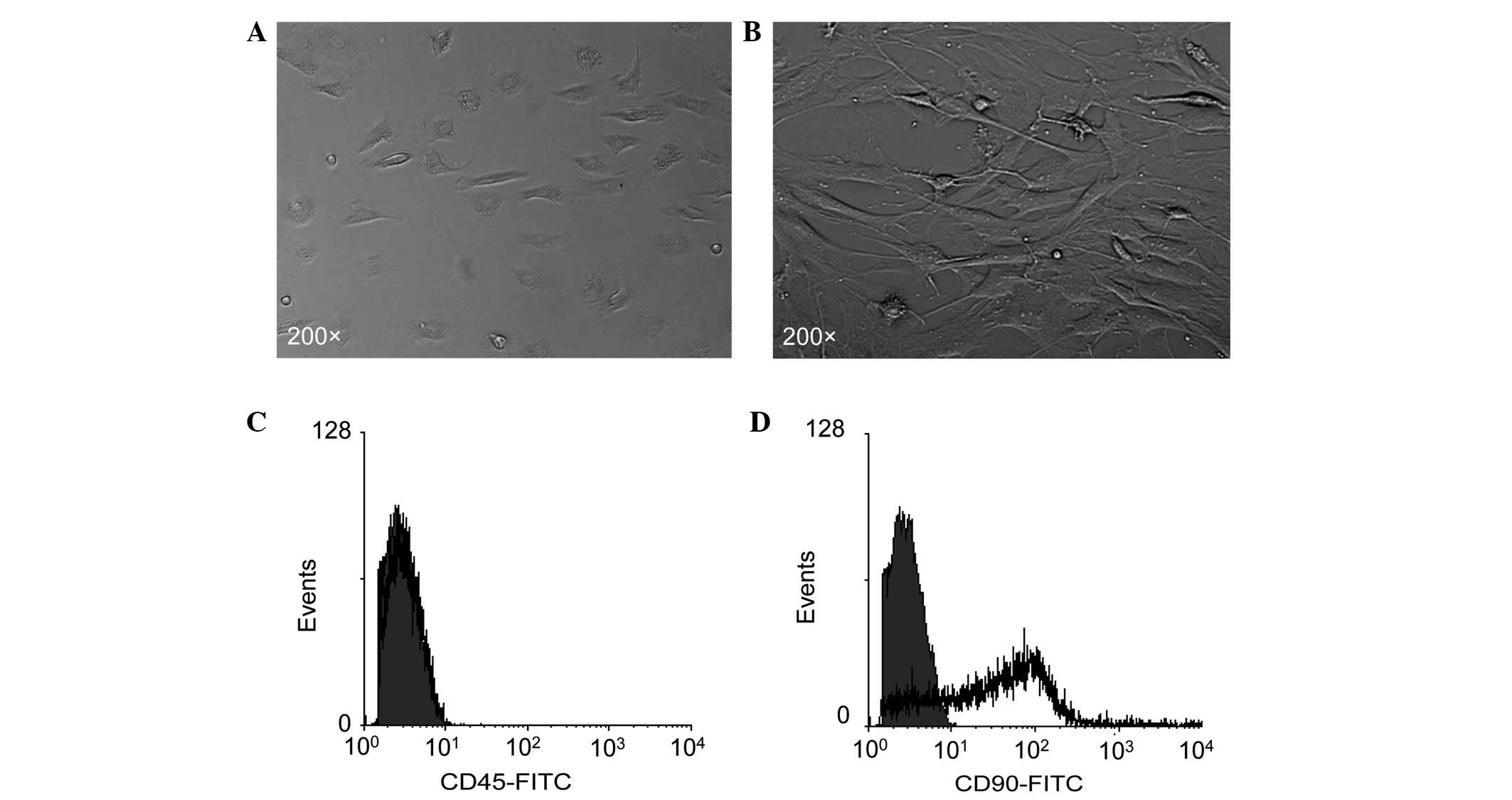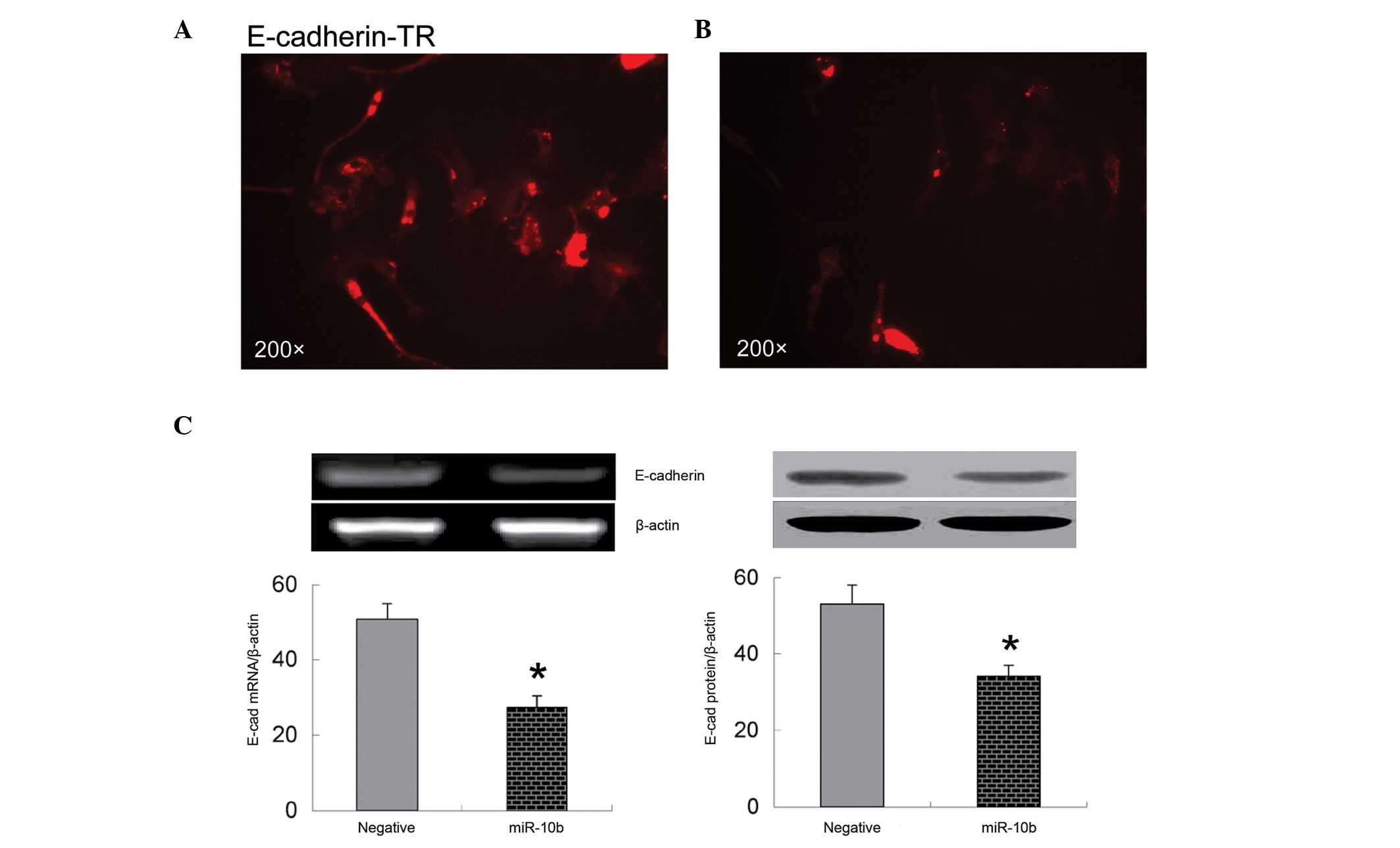|
1
|
Tokaer-Keskin Z, Akar AR, Ayaloglu-Butun
F, et al: Timing of induction of cardiomyocyte differentiation for
in vitro cultured mesenchymal stem cells: a perspective for
emergencies. Can J Physiol Pharmacol. 87:143–150. 2009. View Article : Google Scholar : PubMed/NCBI
|
|
2
|
Oswad J, Boxberger S, Jørgensen B, et al:
Mesenchymal stem cells can be differentiated into endothelial cells
in vitro. Stem Cells. 22:377–384. 2004. View Article : Google Scholar : PubMed/NCBI
|
|
3
|
Hu X, Wei L, Taylor TM, et al: Hypoxic
preconditioning enhances bone marrow mesenchymal stem cell
migration via Kv2.1 channel and FAK activation. Am J Physiol Cell
Physiol. 301:C362–C372. 2011. View Article : Google Scholar : PubMed/NCBI
|
|
4
|
Li C, Feng Y, Coukos G and Zhang L:
Therapeutic microRNA strategies in human cancer. AAPS J.
11:747–757. 2009. View Article : Google Scholar : PubMed/NCBI
|
|
5
|
Kim SJ, Shin JY, Lee KD, et al: MicroRNA
let-7a suppresses breast cancer cell migration and invasion through
downregulation of C-C chemokine receptor type 7. Breast Cancer Res.
14:R142012. View
Article : Google Scholar : PubMed/NCBI
|
|
6
|
Cheng CW, Wang HW, Chang CW, et al:
MicroRNA-30a inhibits cell migration and invasion by downregulating
vimentin expression and is a potential prognostic marker in breast
cancer. Breast Cancer Res Treat. 134:1081–1093. 2012. View Article : Google Scholar : PubMed/NCBI
|
|
7
|
Yan K, Gao J, Yang T, et al: MicroRNA-34a
inhibits the proliferation and metastasis of osteosarcoma cells
both in vitro and in vivo. PLoS One. 7:e337782012. View Article : Google Scholar : PubMed/NCBI
|
|
8
|
Chen J, Chen XR, Zhang R, et al:
MicroRNA-107 inhibits glioma cell migration and invasion by
modulating Notch2 expression. J Neurooncol. 112:59–66. 2013.
View Article : Google Scholar : PubMed/NCBI
|
|
9
|
Wu D, Ding J, Wang L, et al: microRNA-125b
inhibits cell migration and invasion by targeting matrix
metallopeptidase 13 in bladder cancer. Oncol Lett. 5:829–834.
2013.PubMed/NCBI
|
|
10
|
Jurmeister S, Baumann M, Balweierz A, et
al: MicroRNA-200C represses migration and invasion of breast cancer
cells by targeting actin-regulatory proteins FHOD1 and PPM1F. Mol
Cell Biol. 32:633–651. 2012. View Article : Google Scholar : PubMed/NCBI
|
|
11
|
Takeshita N, Mori M, Kano M, et al:
miR-203 inhibits the migration and invasion of esophageal squamous
cell carcinoma by regulating LASP1. Int J Oncol. 41:1653–1661.
2012.PubMed/NCBI
|
|
12
|
Kinoshita T, Hanazawa T, Nohata N, et al:
Tumor suppressive microRNA-218 inhibits cell migration and invasion
through targeting laminin-332 in head and neck squamous cell
carcinoma. Oncotarget. 3:1386–1400. 2012.PubMed/NCBI
|
|
13
|
Chamorro-Jorganes A, Araldi E, Penalva LO,
et al: MicroRNA-16 and microRNA-424 regulate cell-autonomous
angiogenic functions in endothelial cells via targeting vascular
endothelial growth factor receptor-2 and fibroblast growth
receptor-1. Arterioscler Thromb Vasc Biol. 31:2595–2606. 2011.
View Article : Google Scholar
|
|
14
|
Song J, Kim D and Jin EJ: MicroRNA-488
suppresses cell migration through modulation of the focal adhesion
activity during chondrogenic differentiation of chick limb
mesenchymal cells. Cell Biol Int. 35:179–185. 2011. View Article : Google Scholar : PubMed/NCBI
|
|
15
|
Tian Y, Luo A, Cai Y, et al: MicroRNA-10b
promotes migration and invasion through KLF4 in human esophageal
cancer cell lines. J Biol Chem. 285:7986–7994. 2010. View Article : Google Scholar : PubMed/NCBI
|
|
16
|
Fan X, Liu Y, Jiang J, et al: miR-20a
promotes proliferation and invasion by targeting APP in human
ovarian cancer cells. Acta Biochim Biophys Sin (Shanghai).
42:318–324. 2010. View Article : Google Scholar : PubMed/NCBI
|
|
17
|
Madhyastha R, Madhyastha H, Nakajima Y, et
al: MicroRNA signature in diabetic wound healing: promotive role of
miR-21 in fibroblast migration. Int Wound J. 9:355–361. 2012.
View Article : Google Scholar : PubMed/NCBI
|
|
18
|
Zhang LY, Ho-Fun Lee V, Wong AM, et al:
MicroRNA-144 promotes cell proliferation, migration and invasion in
nasoparyngeal carcinoma through repression PTEN. Carcinogenesis.
34:454–463. 2013. View Article : Google Scholar : PubMed/NCBI
|
|
19
|
Li QJ, Zhou L, Yang F, et al: MicroRNA-10b
promotes migration and invasion through CADM1 in human
hepatocellular carcinoma cells. Tumour Biol. 33:1455–1465. 2012.
View Article : Google Scholar : PubMed/NCBI
|
|
20
|
Preis M, Gardner TB, Gordon SR, et al:
MicroRNA-10b expression correlates with response to neoadjuvant
therapy and survival in pancreatic ductal adenocarcinoma. Clin
Cancer Res. 17:5812–5821. 2011. View Article : Google Scholar : PubMed/NCBI
|
|
21
|
Zhang F, Wang C, Jing S, et al:
Lectin-like oxidized LDL receptor-1 expresses in mouse bone
marrow-derived mesenchymal stem cells and stimulates their
proliferation. Exp Cell Res. 319:1054–1059. 2013. View Article : Google Scholar : PubMed/NCBI
|
|
22
|
Kim YS, Kwon JS, Hong MH, et al:
Promigratory activity of oxytocin on umbilical cord blood-derived
mesenchymal stem cells. Artif Organs. 34:453–461. 2010. View Article : Google Scholar : PubMed/NCBI
|
|
23
|
Spencer HL, Eastham AM, Merry CL, et al:
E-cadherin inhibits cell surface localization of the pro-migratory
5T4 oncofetal antigen in mouse embryonic stem cells. Mol Biol Cell.
18:2838–2851. 2007. View Article : Google Scholar : PubMed/NCBI
|
|
24
|
Li L, Hartley R, Reiss B, et al:
E-cadherin plays an essential role in collective directional
migration of large epithelial sheets. Cell Mol Life Sci.
69:2779–2789. 2012. View Article : Google Scholar : PubMed/NCBI
|
|
25
|
Xiao Y, Xu C, Guan J, et al: Discovering
dysfunction of multiple microRNAs cooperation in disease by a
conserved microRNA co-expression network. PLoS One. 7:e322012012.
View Article : Google Scholar : PubMed/NCBI
|
|
26
|
Guessous F, Alvarado-Velez M,
Marcinkiewicz L, et al: Oncogenic effects of miR-10b in
glioblastoma stem cells. J Neurooncol. 112:153–163. 2013.
View Article : Google Scholar : PubMed/NCBI
|
|
27
|
Jamora C and Fuchs E: Intercellular
adhesion, signaling and the cytoskeleton. Nat Cell Biol.
4:E101–E108. 2002. View Article : Google Scholar : PubMed/NCBI
|
|
28
|
Vogelmann R, Nguyen-Tat MD, Giehi K, et
al: TGFbeta-induced downregulation of E-cadherin-based cell-cell
adhesion depends on PI3-kinase and PTEN. J Cell Sci. 118:4901–4912.
2005. View Article : Google Scholar : PubMed/NCBI
|












